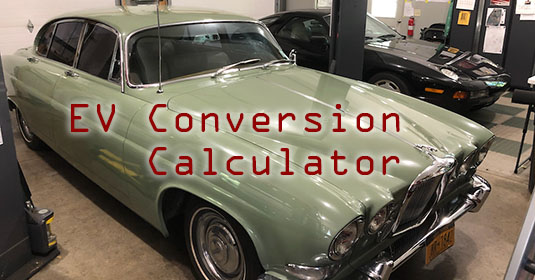
Sponsor this calculator!

Sponsor this calculator!
This calculator is for designing an EV drive system. The starting entries are actually for my own project, a 1966 Jaguar Mark 10. That's a big car that will be powered through a central driveshaft. Just as an example, the calculator is set up for a Zonic 120 motor with a 1.9:1 reduction gearset.
This is a complicated subject, so please read the entire description to learn what this calculator does and does not do. You know, RTFM.
Move the red dot to adjust power; predicted speed will be displayed. Enter your parameters in the green cells. Other predictions are in the purple cells.
The top section predicts speed as you adjust power with the slider. You can input any power - these predictions depend only on the car's weight, tires and aerodynamic resistance, nothing about your motor.
If you input gear ratio, differential ratio and tire diameter, your motor's RPM will be correctly displayed.
If you input your motor's torque, the lower section will provide an estimate of acceleration. Entering an actual torque vs. RPM curve would be tedious, but a reasonable approximation is possible as depicted below:

Essentially, you must enter the two points in this graph. Make sure your operating range to 60 mph or 100 kph is lower than the higher RPM point. Only single-speed gearing is modeled; no shifting allowed. The model assumes your battery, cables and inverter can deliver whatever current and voltage your motor needs.
Initial wheel force is given, which you can compare to available traction. Obviously, the acceleration figure will be wrong if you can smell burning rubber.
Efficiency is considered 100% in the calculations at present. Use your own judgement for the effects of drivetrain loss, electrical loss, the drain of ancillary equipment, and cold weather.
Otherwise, the calculations are fairly rigorous, taking account of the three forces that influence a moving vehicle: air resistance, rolling resistance, and gravity if driving on a grade. The greatest sources of error are from the input parameters. I mean, what's the drag coefficient of a 1966 Jaguar Mark 10?
How have I interpreted the results for my Jaguar? One requirement is that the car can go 70 mph up a 3-mile-long 5% grade on a highway near me. That's a power thing; the Zonic 120 seems fine for that, just within it's continuous rating. A reasonable top speed won't be limited by either motor RPM or power. Acceleration to 60 mph - a matter of torque - will be a bit better than the original car, 10.3 seconds; I'm happy with that. Would it be OK without the 1.9:1 gear reduction set? Nope. Will the car make it to my target destination and back with the batteries I have in mind? Seems so, after taking a healthy deduction.
This is Version 0.91. I've only checked on the reasonableness of the calculation results; bugs may yet emerge. Of course, there are plenty of other things to consider in choosing components for an EV conversion.
Finally, let me share an adage from the engineering community: all models are wrong; some are useful. I hope you find this one useful. If you have any trouble or have suggestions, let me know: curt@bikecalculator.com. Want to sponsor this page? I got a lot of expensive stuff to buy for the Jaguar. Or maybe I'll reward a supplier who proves to be especially helpful.
Sponsor this calculator!